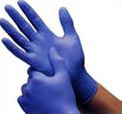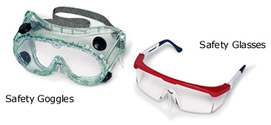Personal Protective Equipment
The type of protective equipment appropriate for your job or research varies with the task and the degree of exposure you anticipate. Equipment that protects you from contact with blood or other potentially infectious materials (OPIM) may include:
Gloves

Gloves should be made of latex, nitrile, rubber, or other water impervious materials. If gloves are particularly thin or flimsy, double gloving can provide an additional layer of protection. If you have cuts or sores on your hands, cover these with a bandage or similar protection as an additional precaution before donning your gloves.
Always inspect your gloves thoroughly before putting them on. Never use gloves that are damaged, such as torn or punctured.
Remove contaminated gloves carefully, avoiding touching the outside of the gloves with bare skin. Dispose of contaminated gloves in a proper container.
Eye Protection
Bloodborne pathogens can be transmitted through the mucous membranes of the eye. Consequently, you should use eye protection whenever there is a risk of splashing or vaporization of contaminated fluid, such as while cleaning up spills or during certain laboratory procedures.

